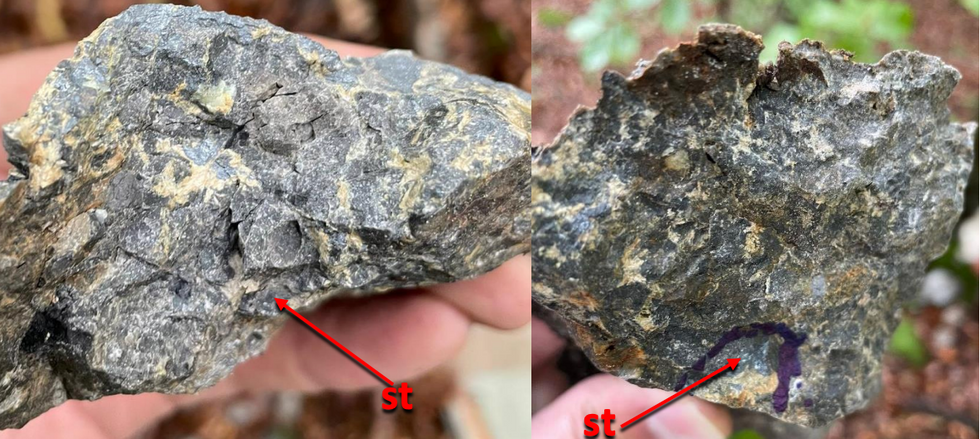Bindi Metals Limited (ASX: BIM, “Bindi” or the “Company”) is pleased to announce an exploration update on the recently acquired Mutnica and Lisa Antimony Projects in Serbia.
Mutnica Antimony-Copper Project:
- Fieldwork commenced successfully locating antimony occurrences at the Kreva Prospect
- 5m wide zone of outcropping variable stibnite-arsenopyrite veins observed at Kreva, including a zone of 5-20% massive antimony stibnite minerals
- Surface rock chip and 2023 soil samples submitted to assay antimony and associated metals
Lisa Antimony-Gold Project:
- Engagement of legal team to facilitate fast tracking of licence grant

Figure 1 Photographs of recent Bindi samples at Kreva 1 (left) Sample DM014022 displaying 5-20% massive stibnite (antimony sulphide mineral; st); (right) Sample DM014024 displaying 1-2% disseminated stibnite (st)
NB: Visual estimates of mineral abundance should never be considered a proxy or substitute for laboratory analyses where concentrations or grades are the factor of principal economic interest. Visual estimates also potentially provide no information regarding impurities or deleterious physical properties relevant to valuations
Bindi Metals Director, Eddie King said:
“We are pleased to have hit the ground running confirming impressive antimony potential at Mutnica and to continue the work Apollo Minerals started on an interesting copper target. In addition, we have formally engaged with in-country advisors to facilitate granting of the Lisa Antimony-Gold Project which was the focus on the transaction with Apollo and considered our key focus in Serbia.”
Mutnica Antimony-Copper Project Update
A team of local Serbian geologists as well as Bindi’s Australian geologist team are undertaking a field campaign around the historical antimony occurrences at Kreva and regional prospecting on the Mutnica licence. The aim of the work was to relocate the historical antimony occurrences that were reported in 2014 (see ASX BIM announcement dated 19 September 2024) and assess the economic significance of these outcrops. Priority samples have been sent to the SGS laboratory in Bor for rush assay on antimony, multi-element and gold assay.
The results of this fieldwork are highly encouraging and the historical Kreva 1 antimony occurrence was successfully located. The area is characterised by intermittent outcrop of vuggy quartz breccia with visible variable 1-5% stibnite (antimony sulphide) together with arsenopyrite (1%) in places. The outcropping zone appears to be approximately 5m wide in thickness but evidence for further antimony sulphide was exposed over a 50m strike zone of intermittent outcrop and open undercover with a dominant northwest to north strike. A standout outcrop was observed in what appears to be a core area of massive stibnite where 5-20% stibnite was observed (Figure 1).
Click here for the full ASX Release
This article includes content from Bindi Metals, licensed for the purpose of publishing on Investing News Australia. This article does not constitute financial product advice. It is your responsibility to perform proper due diligence before acting upon any information provided here. Please refer to our full disclaimer here.
Credit: Source link




